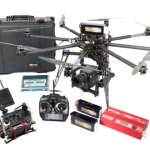By George Eltzroth
Unmanned Aerial Vehicles (UAVs), often referred to as drones, have been used in warfare since the 1970s, but advancements in technology have brought them much closer to home in the last decade. At the moment, drones are most widely used by militaries and hobbyists, both of which have spurred debates about individual privacy rights. As the technology moves into the mainstream and different types of organizations begin to use drones, the need for effective regulation is growing more urgent. The field that arguably needs the most regulation is law enforcement. Public concern about privacy rights has led to a meaningful and ultimately beneficial discussion about what drone regulations in police work should be. Unfortunately, the organizations with the authority to regulate UAVs have fallen short. Some, such as the FAA, have issued regulations so strict that they impede police officers from using drones in any meaningful way. Others have yet to create any regulations at all. In terms of legislation, state and federal governments have a long way to go before they reach a fair and reasonable set of laws.
Strict state and federal regulations make it hard for police to use drones at all, even for purposes other than surveillance and enforcement. The police department in Lindon, Utah has had to halt its use of drones in search and rescue operations because of federal restrictions. According to the city’s Police Chief, Cody Cullimore, the use of drones when looking for lost hikers and campers can reduce a hike of several hours to a flight of five minutes. However, the department stopped using drones in 2015 after learning that they needed a waiver from the FAA, which they had still not received in June of 2016. The waiver requirement would probably not be much of an issue were it not for the inefficiency of the process to acquire one. In the same article, Jay Stanley, a technology expert with the American Civil Liberties Union, says that in this case, the public discussion is ahead of the legislation. Most people would probably agree that search and rescue operations are not a threat to civil rights or privacy, but the FAA’s sweeping regulations have prevented police departments like Chief Cullimore’s from using drones for this purpose.
In addition to federal regulations, many states require law enforcement officials to acquire a warrant before using a drone. However, these laws do not appear to protect individual privacy any more than existing property rights laws already do. Utah currently has a state law prohibiting the use of drones for surveillance without a warrant, as do 17 other states. The first state to pass such a law was North Dakota in early 2015. In an interview with TechRepublic, West Fargo’s Chief of Police, Michael D. Reitan, commented on the law. According to Reitan, the North Dakota Police Officer’s Association is attempting to get the law amended to be less restrictive, allowing law enforcement officers to use a drone like they would any other surveillance device, such as a mounted camera, which in many cases would not require a warrant to install. It seems unreasonable to require a warrant for the use of a UAV in a public area during a public event, such as a parade or marathon, simply because of its mobility.
As an alternative to the current system, drone expert Gregory McNeal proposes taking a property rights approach to drone laws as part of his five recommendations to legislators. This approach would give landowners the right to exclude individuals and aircraft from their property, which extends 350 feet up from the ground. McNeal’s solution achieves the same goal as the warrant requirement, but does so in a way that still enables police departments to use drones for other purposes.
There has also been legislation regarding the use of weapons with UAVs. The aforementioned North Dakota drone law also banned the use of lethal weapons through drones. According to an article by NPR, the law’s sponsor originally intended to ban the use of any weapons, lethal or otherwise, but was forced to compromise, allowing non-lethal weapons to be operated via drone. To some this is still concerning, as even non-lethal weapons can cause injury and even death. The law’s sponsor intends to introduce another bill banning non-lethal weapons as well.
On the topic of arming drones, West Fargo’s Chief of Police, Michael D. Reitan said that while the use of non-lethal weapons could be beneficial in some specific circumstances, drones in law enforcement are primarily used for aerial analysis rather than dealing with dangerous individuals or crowds. However, he also commented that many non-lethal weapons which are currently used blindly, such as canisters of pepper spray and tear gas, could be deployed with much more precision by a UAV. This aspect of the law has more support among law-enforcement officials due to the limited need for armed drones.
There are good aspects to current drone regulation, but there are also many aspects in need of substantial improvement. The current laws paint all use of drones for law enforcement with the same broad brush, but the advantage of drones is that they have such a wide variety of potential uses. When one device can be used for anything from transportation to surveillance, it seems misguided to limit its use in such a big way. That is not to say that fears about invasion of privacy are unfounded, or that drones should not be heavily regulated. They need to be regulated intelligently, in law enforcement and in every other field, if we are to truly unleash the benefits that this technology has the potential to bring.


